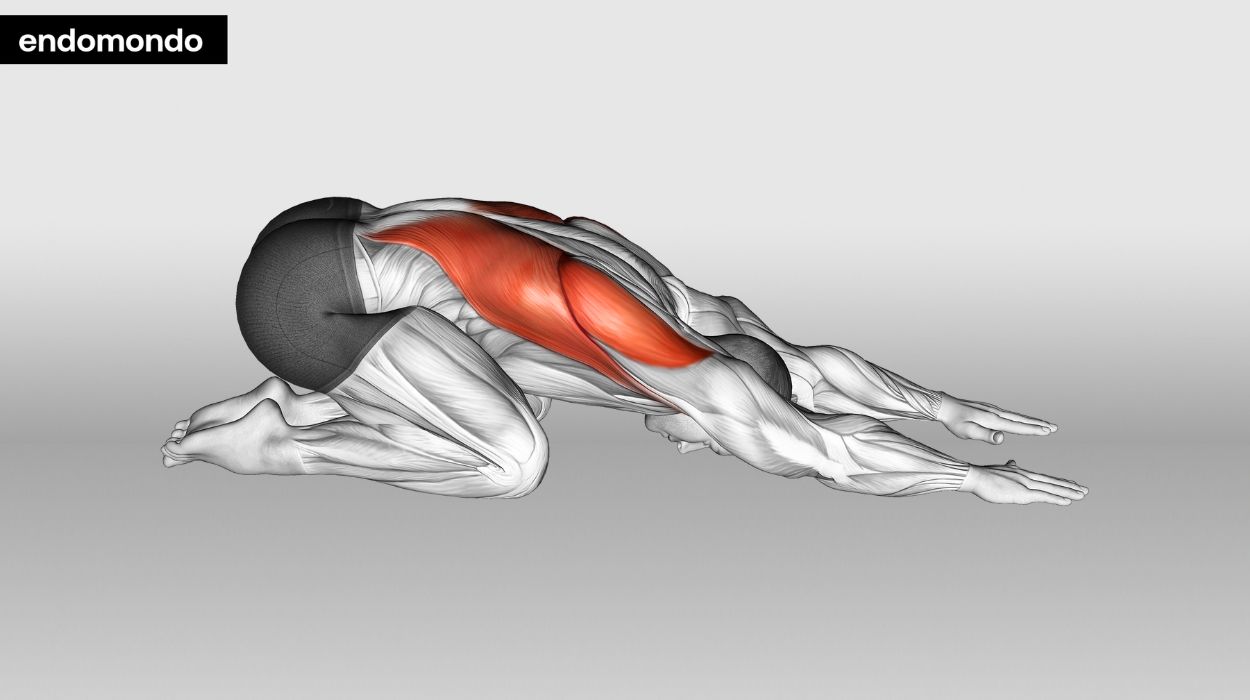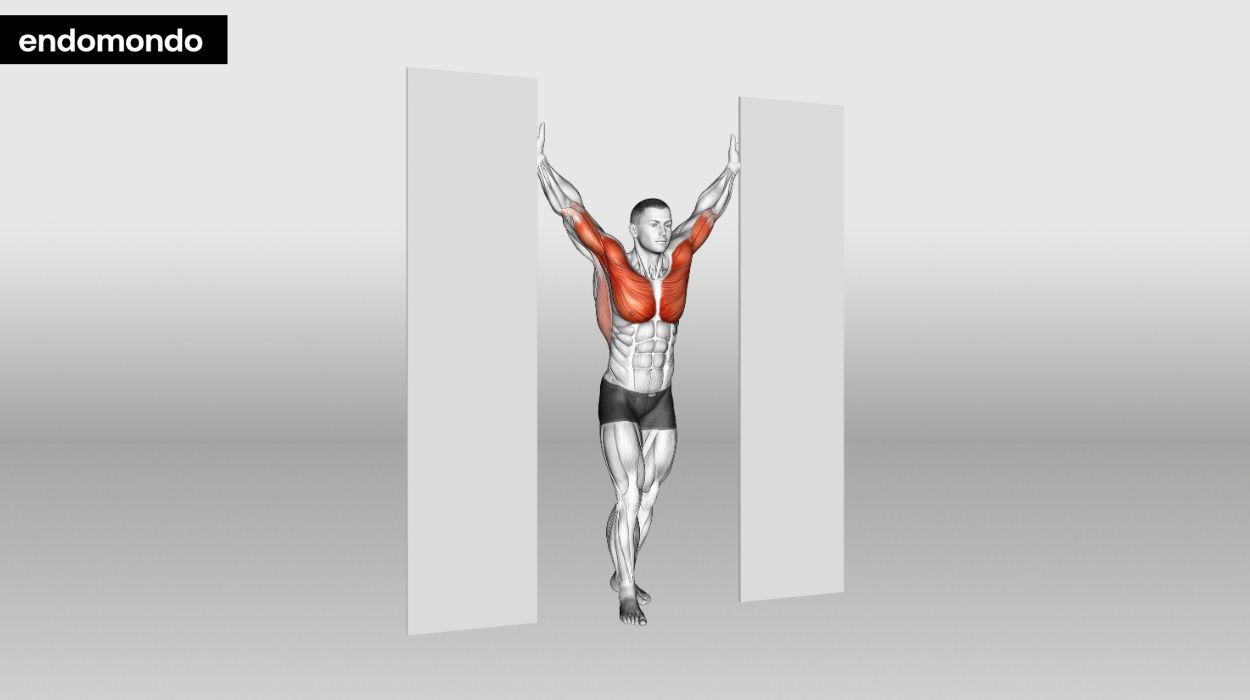
Shoulder pain can be a significant hindrance to everyday activities, often leading to discomfort and limited mobility. It can also reduce your ability to complete normal shoulder workouts. If you’re looking for exercises for shoulder pain to alleviate this issue, you’re in the right place.
Incorporating specific exercises into your routine can provide relief and strengthen the muscles around your shoulder, improving overall function. This article will guide you through the best exercises designed to target shoulder discomfort.
Top Exercises With Shoulder Pain
- Child’s Pose: Targets deltoids, trapezius, and latissimus dorsi. Ideal for stretching, relaxing shoulder muscles, and improving flexibility.
- Pendulum Stretch: Focuses on rotator cuff muscles. Enhances joint mobility and lubrication and reduces stiffness.
- Doorway Stretch: Stretches pectoralis major, minor, and anterior deltoids. Aids in easing chest and shoulder tightness, improving posture.
- Shoulder Blade Squeeze: Strengthens rhomboids and middle trapezius. Promotes better shoulder alignment and posture, reducing pain.
Best Exercises For Shoulder Pain In 2024
Exercise is a powerful tool for managing and reducing shoulder pain. The following exercises – ranging from stretches to strength-building movements – have been carefully selected to target the muscles around the shoulder, enhancing flexibility, strength, and joint stability.
Child’s Pose

Child’s pose is a cornerstone exercise for shoulder pain due to its gentle yet profound impact. Yoga poses like this one are beloved for their simplicity and play a crucial role in stretching and relaxing the muscles around your shoulders and upper back. When you engage in a child’s pose, you are targeting the deltoids in the shoulder and the trapezius and latissimus dorsi muscles in the back – areas that are often tense due to poor posture, overuse, or doing intense upper back exercises.
This pose is particularly beneficial if you need exercises for front shoulder pain or general discomfort in the shoulder area. By incorporating the child’s pose into your routine, found in comprehensive shoulder workouts, you open the door to improved flexibility.
How to do:
- Begin on your hands and knees in a tabletop position by placing your hands shoulder-width apart and knees hip-width apart on a comfortable surface.
- Gently transition your hips back to rest on your heels. Keep your knees wide, ensure your toes are uncurled, and move your feet together so your big toes are touching. As you move, reach your hands forward along the floor, elongating your arms and spine.
- Slowly lower your torso between your thighs as you extend your arms further, maintaining a gentle stretch along your back.
- If you can, allow your forehead to softly touch the ground, anchoring the pose and deepening the shoulder stretch. If you need to, rest your forehead on a block or cushion. Your arms should be active, with palms facing down.
- Maintain this position, taking slow, deep breaths as you relax into the stretch. Hold for 30 seconds to 1 minute, letting the stretch intensify gently with each exhale.
Tips:
- Focus on deep breathing to enhance relaxation.
- Gently stretch your arms further or come up onto your fingertips to intensify the stretch.
Optimal Sets and Reps: 3 sets of 1-minute holds.
Standing Pendulum Stretch
The pendulum stretch is a key exercise for those navigating shoulder pain, and is particularly effective for enhancing joint mobility. This gentle exercise targets the rotator cuff muscles, which are crucial for shoulder movement and stability.[1]
By leaning forward and allowing your arm to swing freely, you will create a therapeutic movement that encourages fluidity in the shoulder joint. This motion helps lubricate the joint, reducing stiffness and promoting a gradual increase in the range of motion.
For individuals looking for exercises for pain in shoulder muscles, the pendulum stretch offers a gentle yet effective way to nurture the shoulder joint. That makes it an ideal inclusion in a comprehensive arm and shoulder workout. Regularly practicing this exercise can pave the way toward regaining comfort and functionality in your shoulder.
How to do:
- Assume the starting position by standing and leaning forward, resting one hand on stable support to keep your spine neutral.
- Allow the opposite arm to dangle, then gently swing it in small circles, no wider than the width of your body.
- Complete 10 rotations clockwise with one arm, then reverse for 10 counterclockwise, ensuring movements are driven by shoulder relaxation.
Tips:
- Keep the movements small and controlled.
- Perform this exercise slowly to avoid any strain.
Optimal Sets and Reps: 3 sets of 10 circles in each direction.
Standing Doorway Stretch

Embrace the doorway stretch, a powerful ally in combating exercises for front shoulder pain. This stretch is an effective way to ease tightness across your chest and shoulder muscles – areas that often bear undue stress from daily activities.
As you press gently into the doorway, your pectoralis major and minor, along with the anterior deltoids, are encouraged to lengthen and relax. Regularly including this stretch – especially as part of a well-rounded front delt workout – can lead to improved posture and a noticeable reduction in shoulder discomfort. This is particularly beneficial for you if you spend considerable time at a desk or in front of a computer, where forward shoulder roll is common.
How to do:
- Position yourself in an open doorway so you are facing the open doorway, arms raised to place your forearms on the frame, elbow bent at a right angle.
- Gently step forward with one foot and lean into the stretch until there’s a comfortable pull across your chest and front shoulders.
- Hold this position for 20-30 seconds, breathing evenly and maintaining good posture.
Tips:
- Don’t push too far into the stretch; it should be comfortable.
- Keep your back straight and avoid arching.
Optimal Sets and Reps: 3 sets of 30 seconds.
Seated Shoulder Blade Squeeze
The shoulder blade squeeze is a strategic exercise for strengthening the muscles that stabilize your scapula, or shoulder blade. This movement primarily targets your rhomboids and middle trapezius. These two muscle groups are essential for maintaining proper shoulder alignment and reducing pain in the shoulder.
By performing the squeeze, you are also indirectly promoting better posture,[2] which is fundamental in mitigating shoulder tension and discomfort. It counteracts the forward hunch that often accompanies prolonged sitting or standing tasks.
Incorporating the shoulder blade squeeze into your rear delt exercises can be the key to unlocking a more resilient and pain-free shoulder area. It’s a simple yet effective step toward alleviating current discomfort and fortifying your shoulders against future pain.
How to do:
- Begin seated with your arms relaxed by your side and a straight posture.
- Draw your shoulder blades toward each other as if pinching a pencil between them; hold this contraction briefly.
- Release gently and ensure that your neck muscles stay loose throughout the movement.
Tips:
- Keep the movements slow and controlled.
- Focus on using your shoulder blades, not your arms.
- Ensure your shoulders are down and not tensed up.
Optimal Sets and Reps: 3 sets of 12-15 repetitions.
Other Methods To Relieve Shoulder Pain
While exercises are a fundamental aspect of managing shoulder discomfort, several other methods can complement your routine to enhance pain relief and recovery.
Heat Therapy
Applying a warm compress or heat pack can soothe stiff muscles and joints, promoting relaxation and blood flow.[3] This is especially helpful before you start your workouts for shoulder pain, as it can make the exercises more comfortable and effective.
Cold Therapy
For acute pain or after engaging in shoulder exercises with dumbbells, cold packs can reduce inflammation and numb sore areas. It’s a quick, immediate pain relief method after intense activity.
Massage
Gently massaging the shoulder can help release muscle tension and improve circulation. Whether it’s a professional massage or a self-administered technique, incorporating this into your push-day workout routine can offer relief and aid muscle recovery.
Tips To Prevent Shoulder Pain
Preventing shoulder pain is about proactive measures that integrate seamlessly into your daily routine. The following tips are designed to fortify your shoulders.
Adopt Ergonomic Work Practices: If your job involves long hours at a desk, ensure your workstation is ergonomically arranged. Your monitor should be at eye level, and your elbows should rest comfortably at your side, reducing strain on the shoulder joints.
Regular Postural Checks: Periodically check and correct your posture[4] throughout the day. If you are slouching, realign your spine, pull your shoulders back, and engage your core to support your upper body.
Flexibility Training: Incorporate flexibility training into your weekly routine. Activities like yoga or pilates can enhance your range of motion and prevent the stiffness that often contributes to shoulder discomfort.
Strength Balance Between Muscle Groups: Ensure you’re completing strengthening exercises for both the front and back shoulder muscles. This will help maintain shoulder joint stability and prevent muscle imbalances that could lead to pain.
Stay Hydrated and Nourished: Good hydration and proper nutrition support muscle health. Ensure you’re getting enough electrolytes and minerals like magnesium[5] and potassium, which contribute to muscle function and recovery.
Warm-Up and Cool-Down: Never skip the warm-up before and the cool-down after exercise. These practices prepare your muscles for activity[6] and then help them relax afterward, preventing injury and pain.
Listen to Your Body: Pay attention to the signals your body sends. If you feel shoulder discomfort during an activity, stop and rest. Pushing through pain can lead to more severe injury.
If you experience shoulder pain without relief, you should consult a healthcare professional to address the issue and receive tailored care.
Conclusion
Incorporating these exercises into your daily routine can significantly impact your shoulder health. With consistent practice, you can expect to see improvements in flexibility, strength and a reduction in pain.
Remember, it’s important to listen to your body and consult a healthcare professional before starting any new exercise regimen – especially if you have chronic shoulder pain.
Frequently Asked Questions
Yes, the right exercises can help alleviate shoulder pain by strengthening and stretching the surrounding muscles. However, more severe cases may need to be seen by a physical therapist.
Exercises like the child’s pose, the pendulum stretch, and the shoulder blade squeeze may effectively manage shoulder pain.
Consistent strength training focusing on the shoulder muscles, including shoulder workouts with dumbbells and cable shoulder workouts, can help in bulking up shoulders. This should be repeated two to three times per week.
Common symptoms include a dull ache deep in the shoulder and difficulty performing activities that involve lifting the arm.
Resources
- Akhtar, A., Richards, J. and Monga, P. (2021). The biomechanics of the rotator cuff in health and disease – A narrative review. Journal of Clinical Orthopaedics and Trauma, [online] 18, pp.150–156. doi:https://doi.org/10.1016/j.jcot.2021.04.019.
- Kim, D., Cho, M., Park, Y. and Yang, Y. (2015). Effect of an exercise program for posture correction on musculoskeletal pain. Journal of Physical Therapy Science, [online] 27(6), pp.1791–1794. doi:https://doi.org/10.1589/jpts.27.1791.
- Malanga, G.A., Yan, N. and Stark, J. (2014). Mechanisms and efficacy of heat and cold therapies for musculoskeletal injury. Postgraduate Medicine, [online] 127(1), pp.57–65. doi:https://doi.org/10.1080/00325481.2015.992719.
- Do Youn Lee, Chan Woo Nam, Youn Bum Sung, Kim, K. and Hae Yong Lee (2017). Changes in rounded shoulder posture and forward head posture according to exercise methods. Journal of Physical Therapy Science, [online] 29(10), pp.1824–1827. doi:https://doi.org/10.1589/jpts.29.1824.
- Shane Michael Heffernan, Horner, K., Giuseppe De Vito and Gillian Eileen Conway (2019). The Role of Mineral and Trace Element Supplementation in Exercise and Athletic Performance: A Systematic Review. Nutrients, [online] 11(3), pp.696–696. doi:https://doi.org/10.3390/nu11030696.
- Park, H.-K., Jung, M.-K., Park, E., Lee, C.-Y., Jee, Y.-S., Eun, D., Cha, J.-Y. and Yoo, J. (2018). The effect of warm-ups with stretching on the isokinetic moments of collegiate men. Journal of exercise rehabilitation, [online] 14(1), pp.78–82. doi:https://doi.org/10.12965/jer.1835210.605.




